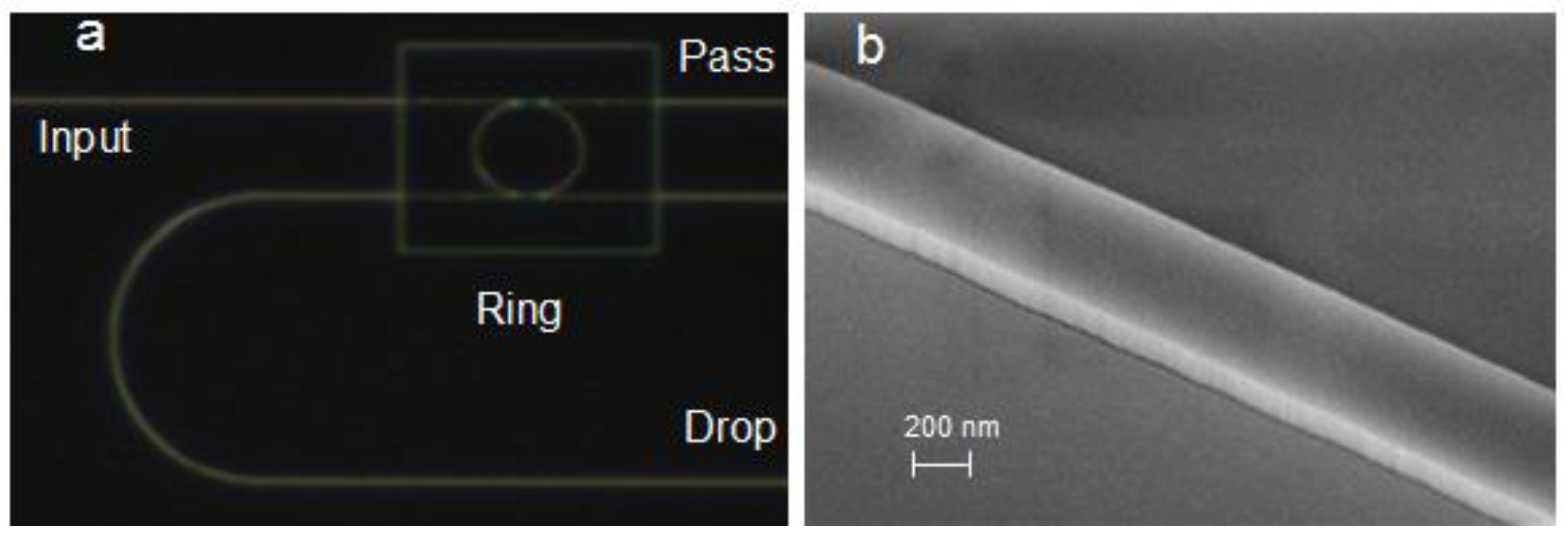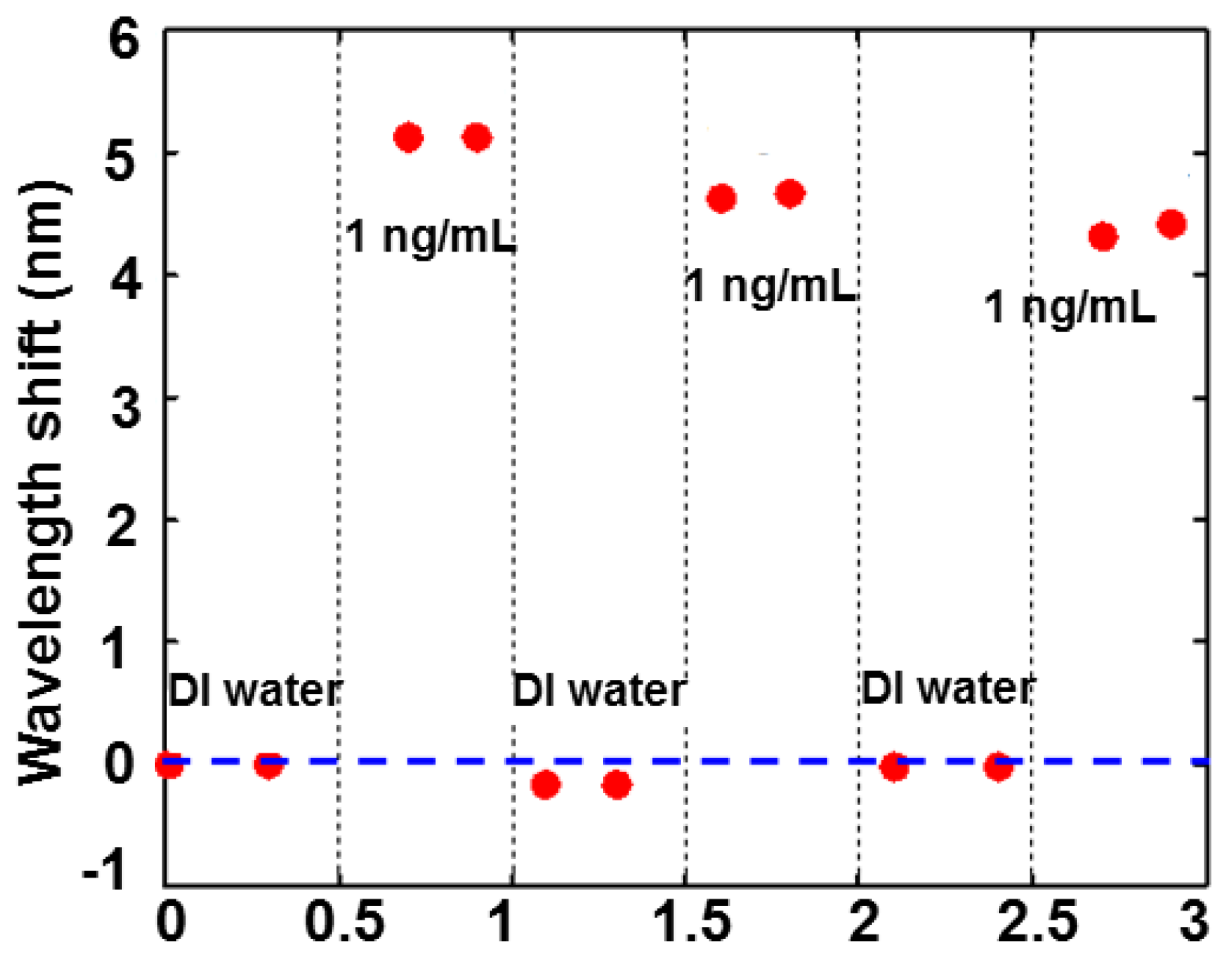Ultrasensitive Detection of Testosterone Using Microring Resonator with Molecularly Imprinted Polymers
Abstract
:1. Introduction
2. Experimental Section
2.1. Reagents
2.2. Instrumentation and Microring Sensor


2.3. MIPs Synthesis

2.4. Testosterone Detection
3. Results and Discussion
3.1. Quantitative Detection

3.2. Specific Recognition

3.3. Reproducibility

4. Conclusions
Acknowledgments
Author Contributions
Conflicts of Interest
References
- Inoue, K.; Ferrante, P.; Yu, H.; Yasukawa, T.; Shiku, H.; Matsue, T. A competitive immunochromatographic assay for testosterone based on electrochemical detection. Talanta 2007, 73, 886–892. [Google Scholar] [CrossRef] [PubMed]
- Cooper, E.R.; Mcgrath, K.C.; AK, H. In vitro androgen bioassays as a detection method for designer androgens. Sensors 2013, 13, 2148–2163. [Google Scholar] [CrossRef] [PubMed]
- West, D.W.D.; Phillips, S.M. Associations of exercise-induced hormone profiles and gains in strength and hypertrophy in a large cohort after weight training. Eur. J Appl. Physiol. 2012, 112, 2693–2702. [Google Scholar] [CrossRef] [PubMed]
- Bos, P.A.; David, T.; Jack, V.H. Testosterone decreases trust in socially naive humans. Proc. Natl. Acad. Sci. USA 2010, 107, 9991–9995. [Google Scholar] [CrossRef] [PubMed]
- Shrivastav, T.G.; Basu, A.; Kariya, K.P. One step enzyme linked immunosorbent assay for direct estimation of serum testosterone. J. Immunoass. Immunochem. 2003, 24, 205–217. [Google Scholar] [CrossRef] [PubMed]
- Mohan, R.K.; Kadwad, V.; Samuel, G.; Venkatesh, M.; Sivaprasad, N. Solid phase radioimmunoassay for testosterone in human serum using antibodies coupled to magnetizable cellulose. J. Radioanal. Nucl. Chem. 2006, 268, 461–466. [Google Scholar] [CrossRef]
- Coyotupa, J.; Parlow, A.F.; Abraham, G.E. Simultaneous radioimmunoassay of plasma testosterone and dihydrotestosterone. Anal. Lett. 1972, 5, 329–340. [Google Scholar] [CrossRef]
- Kalhorn, T.F.; Page, S.T.; Howald, W.N.; Mostaghel, E.A.; Nelson, P.S. Analysis of testosterone and dihydrotestosterone from biological fluids as the oxime derivatives using high-performance liquid chromatography/tandem mass spectrometry. Rapid Commun. Mass Spectrom. Rcm 2007, 21, 3200–3206. [Google Scholar] [CrossRef] [PubMed]
- Taieb, J. Testosterone measured by 10 immunoassays and by isotope-dilution gas chromatography-mass spectrometry in sera from 116 men, women, and children. Clin. Chem. 2003, 49, 1381–1395. [Google Scholar] [CrossRef] [PubMed]
- Cawood, M.L.; Field, H.P.; Ford, C.G.; Gillingwater, S.; Kicman, A.; Cowan, D.; Barth, J.H. Testosterone measurement by isotope-dilution liquid chromatography-tandem mass spectrometry: Validation of a method for routine clinical practice. Clin. Chem. 2005, 51, 1472–1479. [Google Scholar] [CrossRef] [PubMed]
- Passaro, V.M.N.; Dell’Olio, F.; de Leonardis, F. Ammonia optical sensing by microring resonators. Sensors 2007, 7, 2741–2749. [Google Scholar] [CrossRef]
- Passaro, V.M.N.; Dell’Olio, F.; Casamassima, B.; de Leonardis, F. Guided-wave optical biosensors. Sensors 2007, 7, 508–536. [Google Scholar] [CrossRef]
- Ciminelli, C.; Dell’Olio, F.; Conteduca, D.; Campanella, C.M.; Armenise, M.N. High performance soi microring resonator for biochemical sensing. Opt. Laser Technol. 2014, 59, 60–67. [Google Scholar] [CrossRef]
- Katrien, D.V.; Irene, B.; Etienne, S.; Peter, B.; Roel, B. Silicon-on-insulator microring resonator for sensitive and label-free biosensing. Opt. Expr. 2007, 15, 7610–7615. [Google Scholar]
- Dell'Olio, F.; Ciminelli, C.; Armenise, M.N.; Conteduca, D. New ultrasensitive resonant photonic platform for label-free biosensing. Opt. Expr. 2015, 23, 28593–28604. [Google Scholar] [CrossRef] [PubMed]
- Ciminelli, C.; Campanella, C.M.; Dell’Olio, F.; Campanella, C.E.; Armenise, M.N. Label-free optical resonant sensors for biochemical applications. Prog. Quantum Electron. 2013, 37, 51–107. [Google Scholar] [CrossRef]
- Washburn, A.L.; Gomez, J.; Bailey, R.C. DNA-encoding to improve performance and allow parallel evaluation of the binding characteristics of multiple antibodies in a surface-bound immunoassay format. Anal. Chem. 2011, 83, 3572–3580. [Google Scholar] [CrossRef] [PubMed][Green Version]
- Mcclellan, M.S.; Domier, L.L.; Bailey, R.C. Label-free virus detection using silicon photonic microring resonators. Biosens. Bioelectron. 2012, 31, 388–392. [Google Scholar] [CrossRef] [PubMed]
- Washburn, A.L.; Gunn, L.C.; Bailey, R.C.; Chem., A. Label-free quantitation of a cancer biomarker in complex media using silicon photonic microring resonators. Anal. Chem. 2009, 81, 9499–9506. [Google Scholar] [CrossRef] [PubMed]
- Haupt, K.; Mosbach, K. Molecularly imprinted polymers and their use in biomimetic sensors. Chem. Rev. 2000, 100, 2495–2504. [Google Scholar] [CrossRef] [PubMed]
- Bossi, A.; Bonini, F.; Turner, A.P.; Piletsky, S.A. Molecularly imprinted polymers for the recognition of proteins : The state of the art. Biosens. & Bioelectron. 2007, 22, 1131–1137. [Google Scholar]
- Haupt, K.; Belmont, A.S. Molecularly imprinted polymers as recognition elements in sensors. Handb. Biosens. Biochips 2008, 2, 23–39. [Google Scholar]
- Yola, M.L.; Uzun, L.; Özaltın, N.; Denizli, A. Development of molecular imprinted nanosensor for determination of tobramycin in pharmaceuticals and foods. Talanta 2014, 120, 318–324. [Google Scholar] [CrossRef] [PubMed]
- Hao, H.; Zhou, L.; Yi, W.; Li, C.; Jia, Y.; Wei, Z.; Zhang, Q.; Li, M.; Li, H.; Dong, W.F. Detection of trace microcystin-LR on a 20 mhz QCM sensor coated with in situ self-assembled MIPs. Talanta 2015, 131, 8–13. [Google Scholar]
- Zhu, G.; Wang, X.; Gao, X.; Fan, J. Preparation of surface molecularly imprinted polymer and selective extraction of 1-methoxyethyl-3-methylimidazolium bis[(trifluoromethyl)sulfonyl]imide. Monatsh. für Chem./Chem. Mon. 2015, 146, 1–10. [Google Scholar] [CrossRef]
- Gültekin, A.; Karanfil, G.; Kuş, M.; Sönmezoğlu, S.; Say, R. Preparation of MIP-based QCM nanosensor for detection of caffeic acid. Talanta 2014, 119, 533–537. [Google Scholar] [CrossRef] [PubMed]
- Kugimiya, A.; Takeuchi, T. Surface plasmon resonance sensor using molecularly imprinted polymer for detection of sialic acid. Biosens. Bioelectron. 2001, 16, 1059–1062. [Google Scholar] [CrossRef]
- Reimhult, K.; Yoshimatsu, K.; Risveden, K.; Si, C.; Lei, Y.; Krozer, A. Characterization of QCM sensor surfaces coated with molecularly imprinted nanoparticles. Biosens. Bioelectron. 2008, 23, 1908–1914. [Google Scholar] [CrossRef] [PubMed]
- Lotierzo, M.; Henry, O.Y.F.; Piletsky, S.; Tothill, I.; Cullen, D.; Kania, M.; Hock, B.; Turner, A.P.F. Surface plasmon resonance sensor for domoic acid based on grafted imprinted polymer. Biosens. Bioelectron. 2004, 20, 145–152. [Google Scholar] [CrossRef] [PubMed]
- Carlborg, C.F.; Gylfason, K.B.; Kaźmierczak, A.; Dortu, F.; Polo, M.B.; Catala, A.M.; Kresbach, G.; Sohlström, H.; Moh, T.; Vivien, L. A packaged optical slot-waveguide ring resonator sensor array for multiplex label-free assays in labs-on-chips. Lab Chip 2010, 10, 281–290. [Google Scholar] [CrossRef] [PubMed]
© 2015 by the authors; licensee MDPI, Basel, Switzerland. This article is an open access article distributed under the terms and conditions of the Creative Commons by Attribution (CC-BY) license (http://creativecommons.org/licenses/by/4.0/).
Share and Cite
Chen, Y.; Liu, Y.; Shen, X.; Chang, Z.; Tang, L.; Dong, W.-F.; Li, M.; He, J.-J. Ultrasensitive Detection of Testosterone Using Microring Resonator with Molecularly Imprinted Polymers. Sensors 2015, 15, 31558-31565. https://doi.org/10.3390/s151229877
Chen Y, Liu Y, Shen X, Chang Z, Tang L, Dong W-F, Li M, He J-J. Ultrasensitive Detection of Testosterone Using Microring Resonator with Molecularly Imprinted Polymers. Sensors. 2015; 15(12):31558-31565. https://doi.org/10.3390/s151229877
Chicago/Turabian StyleChen, Yangqing, Yong Liu, Xiaodan Shen, Zhimin Chang, Longhua Tang, Wen-Fei Dong, Mingyu Li, and Jian-Jun He. 2015. "Ultrasensitive Detection of Testosterone Using Microring Resonator with Molecularly Imprinted Polymers" Sensors 15, no. 12: 31558-31565. https://doi.org/10.3390/s151229877
APA StyleChen, Y., Liu, Y., Shen, X., Chang, Z., Tang, L., Dong, W.-F., Li, M., & He, J.-J. (2015). Ultrasensitive Detection of Testosterone Using Microring Resonator with Molecularly Imprinted Polymers. Sensors, 15(12), 31558-31565. https://doi.org/10.3390/s151229877





